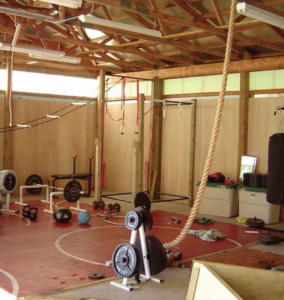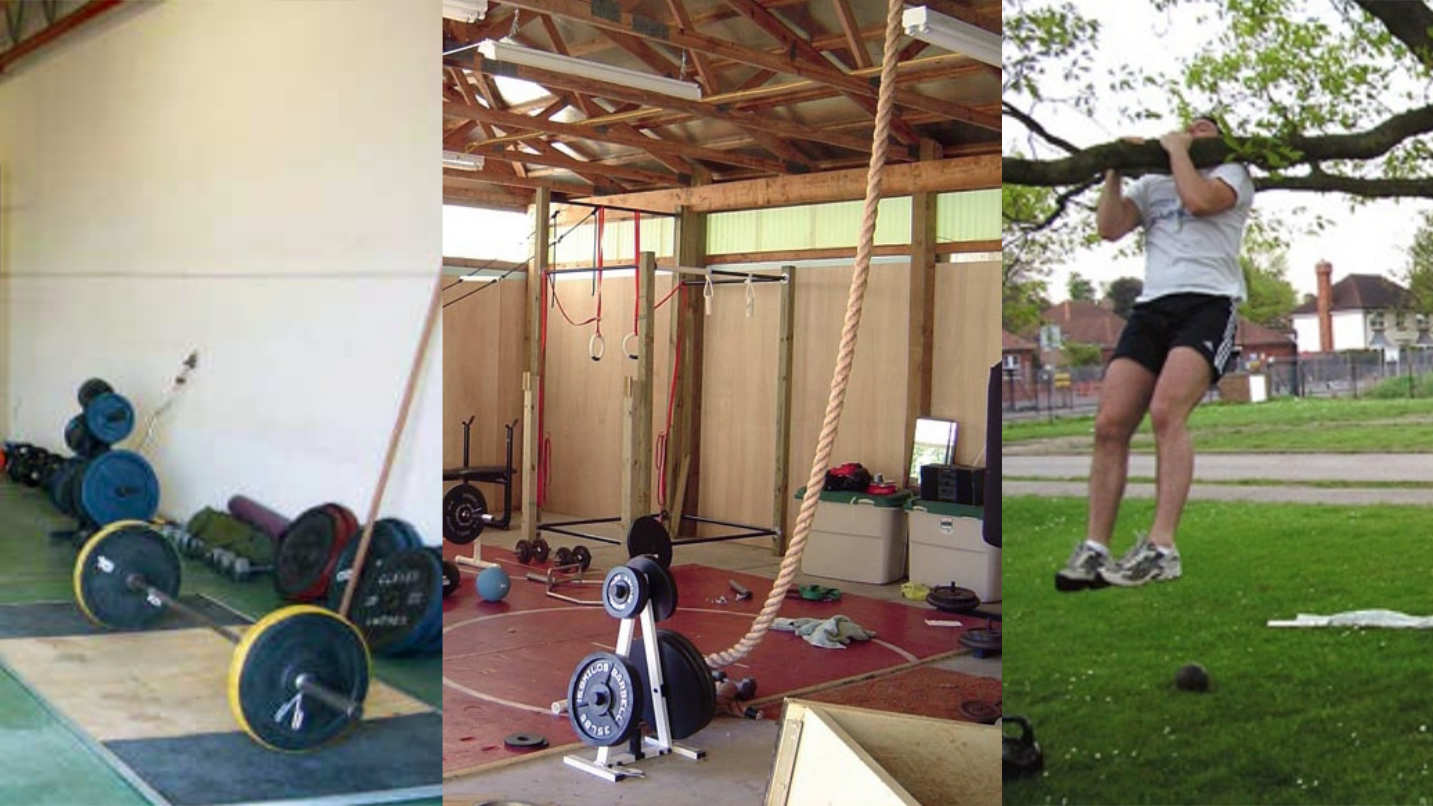By Greg Glassman
This article, by BSI’s co-founder, was originally published in The CrossFit Journal. While Greg Glassman no longer owns CrossFit Inc., his writings and ideas revolutionized the world of fitness, and are reproduced here.
Coach Glassman named his training methodology ‘CrossFit,’ which became a trademarked term owned by CrossFit Inc. In order to preserve his writings in their original form, references to ‘CrossFit’ remain in this article.
Download a pdf of the original article HERE.
 The CrossFit Journal was launched in 2002 with an issue titled “The Garage Gym.” In that premier issue we decried the lack of efficacious programming in commercial gyms and proffered a solution with the promise that “you can build, rather inexpensively, a world-class strength and conditioning facility in your garage!”
The CrossFit Journal was launched in 2002 with an issue titled “The Garage Gym.” In that premier issue we decried the lack of efficacious programming in commercial gyms and proffered a solution with the promise that “you can build, rather inexpensively, a world-class strength and conditioning facility in your garage!”
Now we revisit the CrossFit garage-gym concept to report on the successes of what may be hundreds of CrossFit start-up gyms and the aspirations and motivations of the people behind them.
CrossFitters are holding court in London, New York, New Brunswick, Puerto Rico, Baghdad, Afghanistan, and Qatar. CrossFit crews are convening in public parks, garages and carports, basements, barns, deposed tyrants’ homes, commercial gyms, storage lockers, martial arts academies, and universities, under bleachers, and on military bases.
Three years ago we saw the CrossFit movement as an alternative to the prevailing commercial gym establishment and its signature “big-box,” machine-based, bodybuilding approach to fitness. We promoted the garage-gym notion in large part to provide refuge for our more athletic programming, which couldn’t find quarter in the commercial gyms.
Today we see ourselves as part of a wider war between the big-box franchises such as Gold’s, Bally’s, and 24- Hour Fitness and the small-box facilities of which the Curves chain is the best-known example.
Subject: Unofficial CrossFit Classes
To: info@crossfit.com
From: Eric Lester
Date: July 1st 2005
About 7 weeks ago I started doing the WOD with a friend at my college gym. We’ve since then gotten other people involved and have about 5 regulars doing the WOD including ourselves. I’m expecting that number to grow in the fall when more students arrive.
I’d like to create a website for our little group keeping track of best times for each individual, pictures, etc. I think it would be some fun extra motivation for them all. It’s not like we have a coach or anything, but I tend to take the lead, instruct when necessary, and concentrate on encouraging.
I’m wondering what it would be proper to name our group and page. The guy that started with me suggested “CrossFit ISU” (Indiana State University being our college) and I like that because it raises CF awareness :). But I thought that sort of name was probably reserved for actual CF gyms with a certified instructor…
Over the past decade small facilities of a couple thousand square feet and smaller have made great strides in fighting for market share in the gym industry. Small boxes featuring Pilates, yoga, short workouts, and women’s and kid’s fitness have sprung up in strip malls and shopping centers nationwide.
The market dominance of the big-box model is an interesting phenomenon in that its very size may be the product, ultimately, of a flawed physiological model. If we accept the need for distinct exercises and dedicated machinery for each body part, we create a need for acres of floor space and scores of machines.
The large footprint required for machine-based bodybuilding programming and the extraordinary attendant costs in rent, equipment, and permitting (parking is often a legal issue) squares well with minimum-wage, low-skill, high-turnover employees. At Bally’s you’re renting the floor space, and the kids in polo shirts are decoration. The technology determines the business model.
Square footage, number of floors, and pieces of equipment are to the big-box model what “location, location, location” is to residential real estate. This mindset continues to this day. The large commercial gyms feature Pilates, yoga, or Jazzercise classes only to counter the threat of the smaller, specialized facilities and to remain trendy.
Where do the small-box competitors come from? Often, from the big boxes themselves. In every bodybuilding gym, amidst the machines, there are one or two folks who have discovered the free weights, have an eye for movement, care about the clientele, would like to earn a professional income, and know that they are what keeps people coming back. The members tell them as much. Big-box bodybuilding gyms spawn their best trainers to start and run small boxes. These trainers figure out that bad programming doesn’t need tons of space or equipment—it can be done in a closet.
Out on their own, in their small boxes, they accumulate jump ropes, Swiss balls, an Olympic bar or two, an exercise bike or Stairmaster, a handful of folding mats, and dumbbells in several denominations. The biggest expenses tend to be the cable crossover/lat pull-down apparatus and the mirrors. You’ve seen this facility in dozens of strip malls everywhere—they’re all the same.
What the big-box trainer become micro-gym owner discovers immediately is that everything is better out on his own. The fear of clients not following was groundless (often they initiate or even finance the move), income shoots up even with rent, and life is generally wonderful. A busy trainer in a small box is a happy camper.
The micro gym is vastly more than just a scaled down big-box gym. The big box feeds off membership and is most profitable when thousands sign up and only a few hundred actually come around. The small-box operator is in the training business, and full-participation, high-retention clients are gold. The difference in business models pervades the atmosphere and culture of both models. The client is better cared for in the micro gym and knows it.
Not only does the trainer make more money in his own small facility but, ironically, the programming generally improves precisely because of the lack of resources— i.e., machinery. This is often startling, even exciting, to both the trainer and the client.
A big-box gym in a major metropolitan area in the U.S. sloughs off a top trainer or two every year to have them start their own small private training businesses. Not all go to strip malls or research parks—some start in private residences or garages—but most thrive regardless.
The popularity, successes, and low start-up and operating costs of the small-box gym have inspired a legion of companies offering small gym franchising opportunities. A quick search turns up “Slim and Tone,” “Personal Training Institute,” “Contours Express,” “Elements Diet and Fitness,” “J.W. Tumbles,” “Slender Lady,” “ShapeXpress,” “LA Boxing”, “Anytime Fitness,” “Intrivah Fitness,” “FUNchise,” “Strides Women’s Fitness,” “The Blitz,” “Vert Peak Fitness Centers,” “Fitwize4Kids,” “It Figures,” “Ladies Workout Express,” “Scrimage,” “21 Minute Convenience Fitness,” “Nitro Fitness,” “Club 50 Fitness,” “Designing Women’s Weight Loss,” “IMX Pilates,” “The Little Gym,” “123 Fit,” “Ultimate Woman Fitness,” and “HIT Sports Training Centers”—all from one source alone.
The 800-pound gorilla on the couch, however, is the Curves franchise, with over 9,000 locations worldwide. Entrepreneur Magazine ranked Curves the #2 Overall Best Franchise, #1 Fastest Growing Franchise, #1 Low Investment Franchise, and #1 Fitness Franchise.
Curves runs variable-intensity circuit classes in small gyms with minimal staffing. The Curves workout elicits a cardiorespiratory response from mixed gross-motor recruitment patterns. Participants report that “it’s fun, and it works.”
That is exactly what we do at CrossFit. The similarities are striking. So are the differences. At CrossFit we teach people how to move their bodies, not machines. That’s for starters.
Curves is a franchise. CrossFit is not and will never be. Curves franchisees are intent on making money. Flying the CrossFit flag suggests nothing about monetary intent. CrossFitters are united around constantly varied, functional movement executed at high intensity. CrossFitters affiliate as a confederation of legitimate fitness practitioners pooling reliable resources.
The best of what CrossFit offers, effective programming and constructive community, it does so for free. The family of trainers and trainees working under the CrossFit banner are motivated, to varying degrees, by duty to country, camaraderie, job description, athletic dream, self-improvement, and profit. The communities that CrossFit serves and supports are the best testimonial a fitness program could offer. The individuals who form our community are tribute enough for any enterprise. CrossFit is an Internet-based grassroots movement giving call to all who really care about fitness to get the car out of the garage, pick up some dumbbells, a barbell, a few plates, a pull-up bar, and some rings, and try the Workout of the Day. Inviting a friend to participate will compound the experience. Keep it up and you’ll need a bigger space.
No space? Lack of a facility is irrelevant to the potential. CrossFit NYC started in Central Park. Check out CrossFit Baghdad.
For those contemplating affiliation: making a six-figure income working only mornings is—while not easy— certainly possible and extremely gratifying. Though we offer no formal business model or plan for affiliates, we’ve found that a mixture of group classes and individual training can generate a professional income. Nature and markets will reveal more and less effective business models for affiliates over time.
The commercial success of Curves should give heart to anyone considering a training business powered by CrossFit. Better programming, some windows, and admission of men will not invalidate the potential of the small-box gym.
We want to fuel a revolution in fitness that advocates the pursuit of function, not form—that measures performance, not anatomy. We want rings and bumper plates in our gyms, not machines. We believe that where you train is less important than how you train and that who you train with matters more than what gear you have. We know this can be done in little boxes and we’ve proven that the garage is as good an environment as any for forging elite fitness.
Top Ten Tips for Successful CrossFit Affiliation
1 – Have fun
If you don’t enjoy working out and training, no one will want to work out or train with you. The strongest groups work and play together. Find extracurricular activities for your crew.
2 – Start small and get kicked out
Start in the smallest cheapest space available and move when you outgrow the space. Start in your garage and work out there until the neighbors either all join you or band together to complain about the ruckus. Running out of room means you can afford more space.
3 – Industrial space is better than retail space
Industrial space is cheaper, has higher ceilings, comes with roll-up doors and is generally superior to commercial retail space. Be a destination location.
4 – Don’t kill anyone
Rhabdomyolysis is a potentially lethal threat to newcomers; be very careful. This is a very real and present danger. Avoiding “rhabdo” should be the primary concern of first- and second-time workouts. Throwing a unknown newbie into an established group class is an invitation to rhabdo.
5 – Master the basics
Only by insisting on good fundamentals will a group find success with CrossFit programming. The biggest training mistake we see is teaching advanced movements to folks who haven’t mastered the prerequisites.
6 – Harness the talents of your local crew
The plumbers, electricians, general contractors, fabricators, doctors, lawyers, and accountants among you will be proud to lend a hand. Thriving gyms depend on the resources of all their members.
7 – Lean on www.crossfit.com
The collective talents of the CrossFit family cannot be matched elsewhere. This project is ultimately Internet driven and supported.
8 – Take photos
Document your group’s efforts and milestones with photos and plaster the walls and the web with these photos. Make stars of your best and hardest workers. Build your program’s legacy from day one.
9 – Start with ones and then advance to group classes
The best group instructors have honed their skills through individual instruction. Only very rarely will an instructor without one-on-one experience deliver a professional product to a group. (Your attrition rate will also correlate with the number of your crew who begin with one-on-one instruction.)
10 – Instruct, present, demonstrate
CrossFit is a fitness think tank; lead by thinking. Build your program to be a powerful resource for your community. Handouts, guest lecturers and presenters, discussion, and video will accelerate the understanding and progress of your crew.
- Download Original PDF
- Download Español (Spanish) PDF
- Download Português (Portuguese) PDF
- Download Italiano (Italian) PDF
- Download Français (French) PDF
Greg Glassman founded CrossFit, a fitness revolution. Under Glassman’s leadership there were around 4 million CrossFitters, 300,000 CrossFit coaches and 15,000 physical locations, known as affiliates, where his prescribed methodology: constantly varied functional movements executed at high intensity, were practiced daily. CrossFit became known as the solution to the world’s greatest problem, chronic illness.
In 2002, he became the first person in exercise physiology to apply a scientific definition to the word fitness. As the son of an aerospace engineer, Glassman learned the principles of science at a young age. Through observations, experimentation, testing, and retesting, Glassman created a program that brought unprecedented results to his clients. He shared his methodology with the world through The CrossFit Journal and in-person seminars. Harvard Business School proclaimed that CrossFit was the world’s fastest growing business.
The business, which challenged conventional business models and financially upset the health and wellness industry, brought plenty of negative attention to Glassman and CrossFit. The company’s low carbohydrate nutrition prescription threatened the sugar industry and led to a series of lawsuits after a peer-reviewed journal falsified data claiming Glassman’s methodology caused injuries. A federal judge called it the biggest case of scientific misconduct and fraud she’d seen in all her years on the bench. After this experience Glassman developed a deep interest in the corruption of modern science for private interests. He launched CrossFit Health which mobilized 20,000 doctors who knew from their experiences with CrossFit that Glassman’s methodology prevented and cured chronic diseases. Glassman networked the doctors, exposed them to researchers in a variety of fields and encouraged them to work together and further support efforts to expose the problems in medicine and work together on preventative measures.
In 2020, Greg sold CrossFit and focused his attention on the broader issues in modern science. He’d learned from his experience in fitness that areas of study without definitions, without ways of measuring and replicating results are ripe for corruption and manipulation.
The Broken Science Initiative, aims to expose and equip anyone interested with the tools to protect themself from the ills of modern medicine and broken science at-large.
Support the Broken Science Initiative.
Subscribe today →
recent posts
Medical Society Webinar with David Wiss




